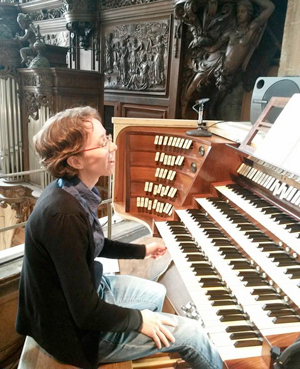by Daniel Hathaway

Demers began with the opening movement of Louis Vierne’s second symphony. A video projection gave the audience a close-up, side view of the artist as she went about her work. Constrained to only a few preset combinations of stops, she managed the 1926 E.M. Skinner organ with efficiency and ease, making smooth transitions between sections of the music and playing with an expressive elasticity of tempo. Vierne’s more complicated textures — three simultaneous layers on two manuals and pedal — seemed child’s play for Demers.
In the first of her pithy spoken comments, Demers noted that Vierne had been “a pretty miserable man,” and that the same was true of Sergei Prokofiev, whose ballet Cinderella provided her with four attractive excerpts to transcribe for the organ. Miserable or not, the composer’s “Introduction,” “Gavotte — The Dancing Lesson,” “Three Oranges,” and “Cinderella gets ready for the Ball” were replete with wry humor and evocative character painting. Demers chose vibrant and amusing stop combinations to paint the little scenes, including the organ’s harp and celesta stops.
Frank Bridge’s Adagio in E introduced a more introspective tone after the Prokofiev. Then came Max Reger’s Fantasy on the Chorale “Hallelujah! Gott zu loben,” a complex, thick-textured set of variations on a hymn that Demers noted the audience might not know, “but would be singing in the shower tomorrow.” Again, the organist made seamless registration changes and negotiated Reger’s dense music with admirable transparency.
After a 15-minute break, Demers returned for a scintillating performance of Johann Sebastian Bach’s Trio-Sonata in G, BWV 530. Many organists — and their audiences — have sweated their way through these demanding, finger- and foot-twisting works, but Demers’ playing amounted to a dozen minutes’ worth of unalloyed musical joy.
Two short studies by French-Canadian organist-composer Rachel Laurin concern themselves with birds. Flight of the Hummingbird features trills in the pedal, nervous pulsations in the manuals, and Debussy-hued chords. Dialogue of the Mockingbirds is a conversation between what Demers described as “one well-behaved bird and another one who wants to show off all the tunes he’s learned at organ recitals.” Bird No. 1 sticks to an endlessly repetitive theme, while Bird No. 2 whistles, among the most easily identifiable fragments, Bach’s Toccata in C and Sinfonia in D.
Non-organists may be surprised to learn that there’s a whole repertory of pieces for the pedals alone. One of the best is Sir George Thalben-Ball’s Variations on a Theme by Paganini, based on the Caprice No. 24 that also inspired variation sets by Brahms, Liszt, Rachmaninoff, Szymanowski, Lutoslawski, and Andrew Lloyd Webber (for cello and rock band).
With this piece, Thalben-Ball, the Australian-born virtuoso who served as organist of London’s Temple Church for six decades — and logged over a thousand recitals at Birmingham City Hall — threw down a challenging gauntlet for his peers. Isabelle Demers took it up with characteristic energy and aplomb, producing effects with her feet alone (chords! polyphony!) that some players would be hard-pressed to play with both hands. Both of Demers’ hands did come into play at the end in a dashing toccata that brought her exemplary recital to an exhilarating conclusion.
Photo: Demers at the organ of St-Étienne-du-Mont in Paris.
Published on ClevelandClassical.com September 22, 2015.
Click here for a printable copy of this article



